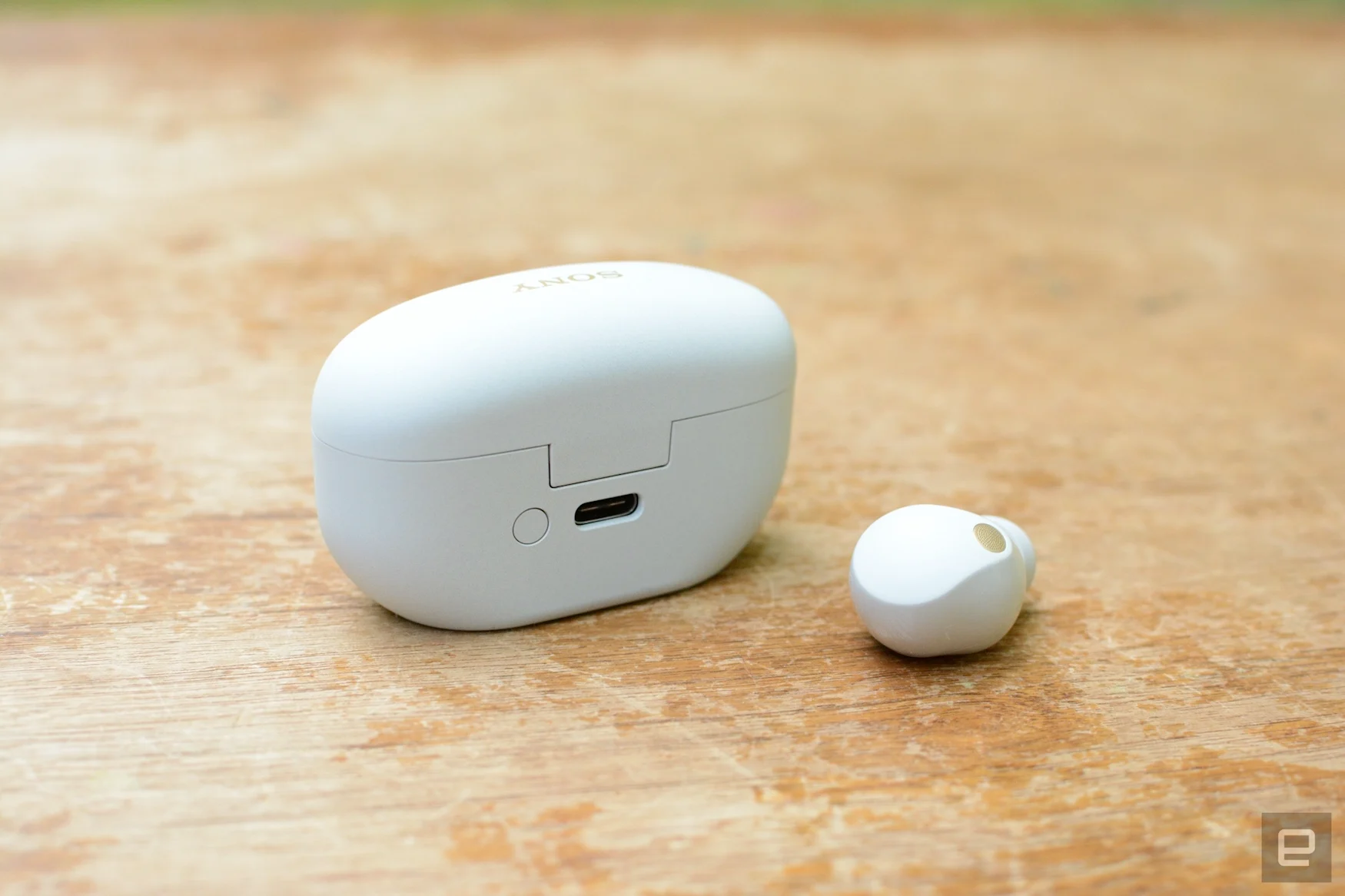With its lineup of 1000X devices, Sony continually sets itself apart from the competition in both earbuds and headphones. Just when it seems like others may be gaining ground, the company adds new features or improves audio quality to keep the top spot on many best lists. Today, Sony is debuting its latest flagship true wireless earbuds: the WF-1000XM5 ($300).
While some of the company’s trademark features return, these earbuds have been completely redesigned, from the overall look to the drivers and even the chips that power much of the functionality. Sony still manages to pack in more tools than anyone else, all while making significant improvements to sound quality. But all of the advancements come at a cost: these are Sony’s most expensive set of wireless earbuds in the 1000X lineup yet.
Pros
- Excellent sound quality
- Improved design
- More comfortable fit
- Loads of handy features
Cons
- More expensive
- No battery life improvement
- Head tracking is Android only
- Some features still need fine-tuning.
Design
For the WF-1000XM4, Sony made big changes to the design of its flagship earbuds. Even with all of the excellent things the WF-1000XM3 offered, those buds were huge and they looked more like Bluetooth headsets. The 2021 model had a different shape and were smaller, but they were still quite big and their weight on the outside of your ear could lead to an awkward fit. Thankfully, the company continued to slim things down with the WF-1000XM5, trimming another 25 percent off the previous model in terms of overall size and losing 20 percent of the weight. For this reason, the new model fits in my ears the best of any 1000X earbuds thus far and they never feel like they’re in danger of falling out.
Sony also slightly updated the ear tips for the M5. Once again, the company opted for squishy foam like it did for the previous model. That switch on the WF-1000XM4 didn’t offer the best fit for me. However, the company says the ear tips are more flexible this time around and it included an extra small size to cater to more ear shapes. The combination of the smaller earbuds and the revamped tips give the the WF-1000XM5 a much more comfortable, more secure-feeling fit than the M4.
Smaller earbuds also means a smaller charging case, but not drastically so. The WF-1000XM4’s was already compact, but Sony slimmed the new version down while giving it a rounder shape. The LED status and pairing indicator on the previous model was a thin strip on the front. That has been replaced by a single dot and the company added a pairing button around back beside the USB-C port. On the M4, you had to put the buds in both ears and then hold your fingers on the touch controls for 5 seconds to put them in pairing mode.
Software and features


Photo by Billy Steele/Engadget
Like most Sony earbuds, the company’s Headphones Connect app is where you customize and activate features or dial in the sound profile. Once inside, tools range from the basics – things like managing Bluetooth multipoint connections, media playback and changing the on-board controls – to more complex items like Adaptive Sound Control.
This is the feature Sony has offered for a while now that automatically changes your noise control preferences based on your activity or location. As always, the latter requires you to give the app access to your location data so it knows when you’re at home versus when you arrive at the office. Adaptive Sound Control is quite handy even if you just use the activity side of the function. You can set it to activate ambient sound (transparency mode) when you start a run. With Adaptive Sound Control enabled, you won’t have to reach for your phone or tap the WF-1000XM5 to get to your preferred settings each time you go from sitting to walking or vice versa.
Under the Sound tab, the app gives you access to noise control (noise canceling, ambient sound or off) right up top. And with ambient sound, you can adjust the level (1-20) and opt to have voices filtered in, with other noise suppressed, via a dedicated passthrough setting. Speak-to-Chat is also here, Sony’s handy tool that pauses the audio when it detects your voice. It’s a nice feature, but it’s still just as susceptible to being triggered by a cough as ever.
The Sound tab is where you’ll also find the EQ, with both manual adjustments and presets available. Sony has added a Find Your Equalizer sound test too, and the beta feature lets you select which sample settings sound best before building your ideal mode. Lastly, 360 Reality Audio setup/ear analysis, Bluetooth connection priority and DSEE Extreme upscaling (on/off) are under this section.


Photo by Billy Steele/Engadget
The System tab is next, which is where you’ll find most of the WF-1000XM5’s controls. You can disable multipoint connectivity, select which voice assistant you want to use and change the on-board controls, including which noise settings you want to cycle through. The M5 supports hands-free access to Google Assistant and Alexa, so you can play music, send messages, get notifications, set reminders and more without touching the earbuds or your phone. Google Assistant can also control certain features of the WF-1000XM5, including enabling ANC or ambient sound, with a spoken cue.
What’s more, Sony has added a quadruple tap action for volume control, so you no longer have to sacrifice something else to get that function on your earbuds. Four taps on the left lowers the volume while four on the right raises it. All of the playback controls are now on the right side by default and Sony gives you two “quick access” slots for connected services by double and triple tapping on the left earbud. Options for this are currently limited to Spotify and Endel, though. You can also opt to hear some of your voice during calls and to use head gestures for incoming calls or to activate Auto Play. There’s an earbud fit test and automatic options for both pausing when the earbuds are removed and turning them off when they’re not in your ears.
Auto Play, a tool that’s still in beta, can detect your activity and deliver a mix of music and notifications you’ve selected for it. Activities can range from putting the earbuds in your ears to starting a walk or ending your work day. You can also silence notifications or let important messages through. Right now, Auto Play can only be linked and customized with Spotify and Endel, but it’s yet another way Sony is trying to automate your relationship with your earbuds so you don’t have to reach for your phone as often.
Sound quality


Photo by Billy Steele/Engadget
Sound quality has never been an issue 1000X earbuds, but Sony made significant changes on the M5 in a bid to make the audio even better. First, the company opted for dual processors, an approach it has taken on the 1000X family of over-ear headphones. Here, the QN2e chip handles noise canceling alongside the main V2 processor. These two components combine for 24-bit audio and a more powerful integrated digital-to-analog converter (DAC).
Sony has also installed redesigned drivers that it’s calling Dynamic Driver X. These are 2.4mm larger than the speakers on the M4 earbuds and have a separated dome-edge structure diaphragm. The company says the new components offer “rich and more detailed vocals” along with “low distortion and a clear sound quality.” There is a noticeable improvement to overall clarity on the WF-1000XM5, especially when it comes to vocals. Lynn Gunn’s lyricism on PVRIS’ Evergreen cuts through more clearly on the M5 when compared directly with the M4, allowing her hooks to rise above the onslaught of chunky, distorted guitars and driving bass lines.
There are also big gains on the low end of the EQ curve. Bass is bigger and boomier on the WF-1000XM5, something I noticed immediately after getting reacquainted with the M4. There’s more driving thump to the low-end throughout that PVRIS album and a pleasant, clicky pop to the kick drum on Chris Stapelton’s “White Horse.” Over a range of genres, the sound profile on the M5 sounds bigger and fuller with a natural dimensionality that doesn’t require 360 Reality Audio to immerse you in an album.


Photo by Billy Steele/Engadget
I did most of my testing with Sony’s DSEE Extreme upscaling active as that’s where the company’s headphones really shine. Like other of the company’s premium earbuds, the WF-1000XM5 supports Hi-Res Audio along with its own 360 Reality Audio (360RA) tech. In addition to being able to calibrate 360RA to your ears, Sony has now added head tracking to its take on spatial audio. While it does offer a slight improvement to the immersive nature of the audio standard, you’ll need an Android device and compatible apps (Netflix, YouTube, et cetera) to use it.
The decision to split audio and ANC processing on the WF-1000XM5 also has implications for the overall effectiveness of the noise-canceling setup. Sony says the QN2e chip can now control the six-microphone array (three on each earbud) more precisely. The V2 chip assists with real-time signal processing. The company also says those dual-feedback mics can now monitor low-frequency noise better, battling things like airplane and vehicle clamor more efficiently than the M4. I found this to hold true, although I would’ve liked to see some improvement with how the ANC handles human voices as there’s not much change to the effectiveness at higher frequencies.
Call quality
Overall call quality was noticeably better than much of the competition on the WF-1000XM4. That’s mostly due to the inclusion of bone-conduction sensors alongside the usual beamforming microphones. That dual-tech approach is back on the M5, but Sony has added a dash of AI to help you sound better on calls too. The company says its new noise-reduction algorithm is built on deep neural network processing and trained on 500 million voice samples. The result, as Sony explains it, is the WF-1000XM5’s ability to more accurately extract your voice from ambient noise. Microphones were also rebuilt and wrapped in mesh to minimize wind noise.
In practice, Sony once again does a great job of blocking background noise. A nearby white noise machine didn’t come across on my calls at all, nor did a raucous preseason soccer exhibition on my television. Voice clarity is far from perfect, but it’s better than a lot of the competition. You don’t sound muffled, though your speech does lack the natural warmth you get from a standalone microphone or by holding your iPhone or Google Pixel up to your face.
Battery life


Photo by Billy Steele/Engadget
One area Sony didn’t improve things was battery life. Just like the previous model, the company says you can expect up to eight hours with ANC turned on. The 24-hour total listening time with the case (2 additional charges) is also the same. If you disable active noise cancellation, Sony promises up to 12 hours of use with 36 hours total including the case, which is also unchanged. The company did slightly upgrade its quick charge feature which now gives you an hour of use in three minutes – versus five minutes on the M4. And just like before, the case supports both wireless charging and topping off via USB-C.
During my tests using both ANC and transparency mode at various times, doing a mix of music and calls, I managed just under seven hours. The numbers really started to tumble after about six hours at around 20 percent left. Seven hours is a full hour below Sony’s estimate, but I did have DSEE Extreme upscaling turned on the whole time which likely impacted battery performance. The WF-1000XM4 didn’t make it to the stated number during my review of those either, so hopefully the company either remedies this or clarifies how much its audio upscaling tech impacts these figures.
The competition
Sony sits atop our best wireless earbuds list thanks to the volume of features it offers on the WF-1000XM4. Sure, the sound quality is great and the ANC does a stellar job, but there are alternatives that do better in each of those areas. Sennheiser’s Momentum True Wireless 3 is my top pick when it comes to pure audio performance, though Sony closed the gap significantly with the M5. Sennheiser’s earbuds have always had great sound, and it too continues to improve with each successive model. Sennheiser has also made upgrades to ANC and other features along the way. Plus, you can currently get them on sale for around $163 – over $100 less than the full price of $279.95.
If you’re looking to silence the world with your wireless earbuds, Bose’s QuietComfort Earbuds II should be your consideration alongside the WF-1000XM5. Besides blocking out your typical distractions, the company improved its earbuds’ ability to cancel human voices. Overall sound quality is improved over the first QuietComfort Earbuds, but it’s still not on the level of Sony or Sennheiser. The QCE II are currently on sale for $50 less than full price at $249.
Lastly, let’s have a word about the AirPods Pro. It’s true they’re only worth considering if you’re invested in Apple’s ecosystem, but features arriving later this year with iOS 17 make them a better alternative to Sony’s 1000X line than before. Apple will introduce Adaptive Audio this fall, which automatically tunes noise cancellation and transparency model levels for your environment. Personalized Volume will adjust levels based on both your surroundings and listening preferences. And perhaps most importantly, Apple will add Conversation Awareness that automatically lowers volume or pauses audio when the AirPods Pro detect your voice. That’s very similar to Sony’s Speak-to-Chat, a feature I’ve enjoyed using despite its flaws. You’ll need the second-gen AirPods Pro for these upcoming updates, which can be currently found for $199.
Wrap-up
With the WF-1000XM5, Sony improves its already formidable mix of great sound, effective ANC and handy features. These earbuds are undoubtedly the company’s best and most comfortable design in its premium model so far, which was one of the few remaining riddles Sony needed to solve. For all of the company’s ability to add so many features, many of them still need fine-tuning, but that doesn’t make them any less useful in their current state. The WF-1000XM5 are more expensive too, which means the competition has one key area it can beat Sony. As is typically the case, there aren’t many flaws with the company’s latest model and its rivals still have their work cut out for them.
The WF-1000XM5 are available for pre-order now in black and silver color options for $300. According to Amazon, the earbuds will ship on August 4th.
Gallery: Sony WF-1000XM5 review | 14 Photos
Gallery: Sony WF-1000XM5 review | 14 Photos
This story originally appeared on Engadget

